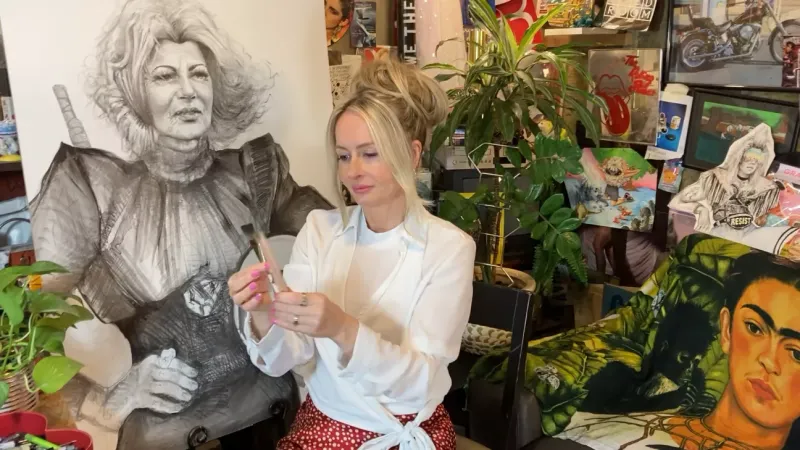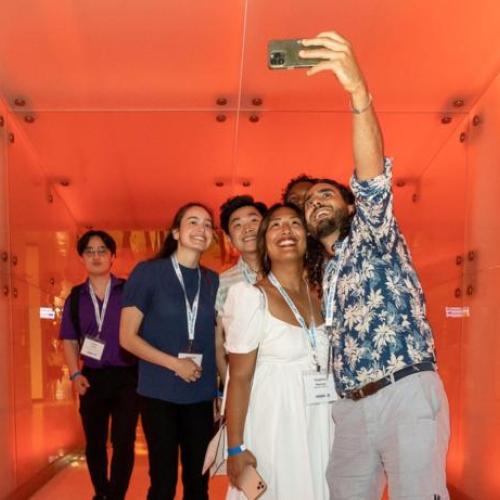February 29, 2024 | Alumni
Exploring art, wellness and community with alum Erin Finley
By Tara Clemens

"Art is for everyone": UTM Art & Art History alum Erin Finley is wielding the power of art to bring communities together.
At a beautiful intersection of creativity and community, University of Toronto Mississauga graduate Erin Finley (HBA 1998 UTM, BEd 2000 OISE) has found inspiration through inclusion. Recognized as a gifted artist and teacher, Finley has explored the profound impact of drawing as a medium, emphasizing its accessibility and therapeutic potential for all. Through the Memory Drawing project Finley has introduced to long-term care facilities, she invites residents to rediscover memories and forge connections through art.
From teaching accolades amidst the challenges of the pandemic to receiving grants for her therapeutic art initiatives to her unwavering belief that “art is for everyone,” Erin sat down with us to share her inspirational journey of wellness and community through art.
What did you enjoy most about UTM's Art & Art History program?
I loved expanding my imagination through the Art & Art History program. I also majored in English at that same time, so I embraced every opportunity for cross-pollination between art and writing. My favourite courses focused on poetry because I could fuse mark-making, writing and performance art. I remember performing a Sylvia Plath poem at a UTM poetry festival – not just reciting it, but ‘performing’ it like a performance artist.
When I launched my Memory Drawing project, which uses art to revive the memories of long-term care residents, I tapped into my appreciation for those courses. I often invite participants to think about a favourite poem or a favourite piece of writing to accompany their drawings.
What do you love about drawing as a medium?
Drawing is such a beautiful act. It’s about making a mark, which is such a loaded idea. The marks we make on a page can be radical, revolutionary, permanent. They can also be ephemeral, malleable, erasable. The materials we use carry meaning also, so it becomes a lovely, defiant act to draw with unorthodox materials.
Everyone draws, often without realizing it. At the beach, when little children run their fingers through the sand, they are making drawings. I also love that it doesn't require a lot of materials: you just need a drawing implement and a surface to draw on. Some of the most compelling drawings are made with unlikely mediums. Even if all you have are everyday household materials, you can create the most exquisite images. I recently saw a beautiful drawing made with orange soda; it looked like a watercolour painting.
You like to say “art is for everyone.” Can you share about what that means to you?
I am very passionate about this idea! Art is for everyone. Making art is a joyful act that shouldn't be just for certain groups who can afford or have access to it. When I created my memory-revival drawing program, this was top of mind: I wanted to make sure that all participants, regardless of their dexterity level, could engage with the art-making. One of the long-term care participants does not hold a pencil and instead manipulates paint only with his thumbs – and with such beautiful results!
When art is for everyone, we create space for everyone to bring their voice and life experience to the work. This is also evident in how we draw, literally how we make contact with the page. Our mark-making becomes a kind of fingerprint. It tells a story.
You refer to yourself as a wellness community builder. Can you talk about what that means?
I grew up in Mississauga, and I come from a creative family. As a young artist, wellness was important to me, even though that term was not really used then. My mom was an artist, and I remember she would invite my grandparents over, and we would tell stories through drawing. These were some of my most joyful childhood memories. As an adult, I now realize that the wellness aspect of those moments came from bringing three elements together: creativity, community, and storytelling. My Memory Drawing work was borne of that idea.
It also was borne of the success of the live art encounters I have held at OCAD University, where I've been teaching for over a decade. At OCADU, I am known for hosting popular events like the ‘Drawing Disco,’ where the public is invited to sketch a live model while listening to music or dancing. After launching my first Drawing Disco through an OCADU International artist residency, I was surprised to learn just how many participants felt it was good for their wellness to get together and draw. Drawing allows us to slow down and focus our attention, and it promotes a sense of calm and relaxation.
You taught drawing classes at the Centre for Addiction and Mental Health (CAMH) through the Workman Arts division. What did you learn during that experience?
I loved working with CAMH artists. Many students were going through a lot, and they channelled their emotions through their art. They remain among the bravest artists I have worked with. It was powerful to watch people find healing through drawing. There, I learned about the significant positive psychological impact of creative activity. I remember one artist struggling to find her voice after experiencing a trauma, so to reclaim her space and voice, she would make big sweeping marks on huge canvases. This was her way of expressing her life story.
Watching artists release trauma and work through important life events through drawing was inspiring. I also noticed that even if people are on different life journeys and have vastly different skill levels, they can still gain from creating art in a communal setting.
Teaching studio art classes virtually during the pandemic must have been tricky, but you actually won your second teaching award from OCAD during that difficult time. Can you talk about how art can build community – even virtually?

Yes, I'm honoured to be the recipient of two teaching awards at OCAD University, and one of the awards was for my innovative practices in teaching during the pandemic. That year, I turned my online class into a community-building opportunity where we would push the limits of drawing. Even though we covered all the technical content you would expect in a drawing course, we also drew from our imaginations with activities that were couched in wellness, joy, and shared experiences.
We overcame challenges around supply-chain issues impacting the art world at that time, often drawing with household materials and with stunning results. For instance, in lieu of ink, we used soy sauce. We used Q-tips to blend our drawings instead of using professional blending implements.
Another key to the success of that online year was co-creating a comfortable ambience for the room with the students, even though the room was a virtual one. One of the students would play guitar for us regularly, and while he was onscreen, we would create gesture drawings of him. It often felt like a party or a get-together, and attendance was almost 100 per cent the whole time. Even years later, those students still tell me how much they enjoyed the time we spent drawing together.
During the pandemic, you received a grant through the Canada Council for the Arts to bring art to long-term care facilities. What inspired you to do that?
I was so moved by the long-term care images we were seeing on the news – footage of people unable to be with their loved ones and dealing with loneliness and isolation. I wanted to make a difference, but I wondered, as an artist, what I could do. That’s when the idea came to me: I could provide joy and community-building through art.
Support from the Canada Council for the Arts meant so much to me. It meant I was able to obtain drawing materials for participants to create art through Memory Drawing. I volunteer my own time to the project and the sessions themselves, so it was awesome to have the Canada Council help me provide materials for each session. It has been tremendous to grow the program and see its incredible impact on long-term care residents.
Can you talk about “Memory Drawing”?
The goal of Memory Drawing is to revive memories and create art in a therapeutic way. My program invites long-term care residents to combine art and language to tell stories. I will invite them to try a drawing prompt, like, ‘Draw the sounds and sights of autumn,’ and they will think about the textures, the colours, or memories of that season. They are encouraged to imagine using the sounds of trees moving in the wind, for instance, and we often have music playing while they do this. We also discuss their drawings and what it feels like to conjure memories through drawing.
I launched the program a year ago, initially creating art with residents at Cooksville Care Centre in Mississauga and then Eatonville Care Centre in Etobicoke. It has been great to hear from residents that they are excited to connect with me and with each other each time we have an occasion to embark on a new memory prompt and a new drawing.
Where would you like to see your Memory Drawing project go next?
The responses to my Memory Drawing project have been overwhelming. The exposure through international and local media outlets has helped me promote drawing as a tool for exercising memory. I hope to expand the project and reach more people in long-term care. I would love to see Memory Drawing participants be able to share and showcase their art. Many of them have developed substantial bodies of work, and I would love to honour and celebrate their work in a gallery setting.
What would you say to aspiring artists and new graduates?
I would say that finding your passion will help carry you through life’s tougher moments. When I was an emerging artist finishing my MFA, my mom passed away rather suddenly. I leaned into my passion for art then, and it helped me to make meaning from her loss.
The other piece of advice I would give any new graduate is to believe in yourself. One of the most interesting things about being an artist is that you actively learn to trust yourself with each creative decision. You become rather intentional about it. With every stroke of the pencil, I am aware that I have to trust myself with the process if I am going to love the results.

